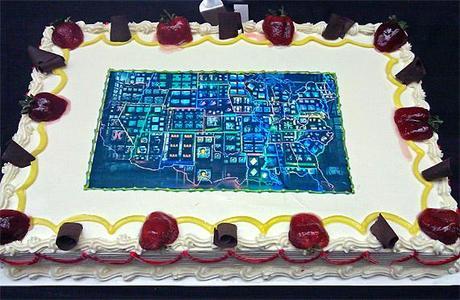
Birthday cake for Nam June Paik featuring his work Electronic Superhighway: Continental U.S., Alaska, Hawaii on display at American Art.
"Watch this. You've got to see what I'm doing," an enthusiastic Nam June Paik would say to John Hanhardt, his longtime friend, curator, and currently curator of new media at American Art. Paik, who died in 2006 at the age of 74, is long considered the father of video art. Born in Korea, he arrived in New York City in 1964 and almost single handedly transformed the art of the moving image. To celebrate what would have been his 79th birthday on July 20, John Hanhardt was joined by Paik's nephew Ken Hakuta and artist Jim Campbell for a talk about Paik, his work, and his influence on a new generation of artists. Fittingly, we gathered in American Art's handsome gallery dedicated to media arts, currently featuring the exhibition, Watch This! New Directions in the Art of the Moving Image. After, it was time for a slice of birthday cake.
The event began with comments by Hanhardt, "This is a wonderful occasion, celebrating Nam June Paik's birthday. I can't think of a better place to do it than American Art." He then went on to mention two large Paik pieces that are on view: Megatron/Matrix, calling it "a wall of movement that transforms our idea of the moving image, and Electronic Superhighway: Continental U.S., Alaska, Hawaii, "which celebrates this country which was so important to Nam June."
Ken Hakuta remembered what it was like spending time with his uncle in the 1960s and being present for the creation of some of his seminal works, including two for cellist Charlotte Moorman. "Nam June was my guardian," Hakuta told us and I spent my time surrounded by all these wacky Fluxus artists." James Campbell, trained at MIT and represented by two works in Watch This!, talked of Paik's influence on a new generation of artists who would manipulate video as an art form. He commented on the impact of Paik's TV Buddha from 1974, had on his own art: "That work changed my life and made me see video in a different way, as well as time in a different way."
Hanhardt explained another connection between Nam June Paik and the museum, "The other thing that makes American Art a special place is that it's now the home of Nam June's archive. It's an enormous trove of materials that provides insight into the artist's creative process." What's more, objects from Paik's archive will go on view in the museum in 2012 in an exhibition titled, Nam June Paik: Art and Process.

